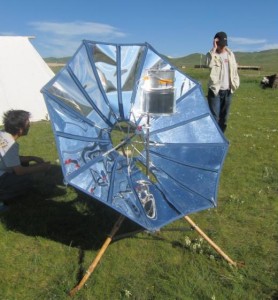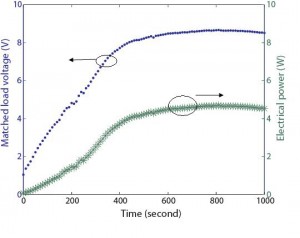Solar Thermoelectric Generator for the developing world
- Category: Energy
- Tags: Rajeev Ram, Reja Amatya
With nearly 1.6 billion people living without electricity, the demand for small-scale distributed power generation is high. In developing countries, especially in rural communities, residential electricity consumption is less than 0.5kWh per day which is used for lighting and powering household appliances such as televisions, radios, and satellite receivers [1] . Till now, solar photovoltaics (PV) have been the prominent source for rural electrification, but the penetration has not been very rapid, primarily due to the large upfront system cost for the panels. Previously, we have designed and demonstrated a Solar Thermoelectric Generator (STEG) using concentrated sunlight (66x suns) incident on a Micro Alloyed Material Bi2TE3 thermoelectric module with a selective surface coating achieving 3% peak efficiency [2] . This approach was shown to be cost competitive with small-scale solar PV. We have demonstrated that a STEG can be integrated into solar cookers, which are widely deployed in the developing world to sterilize drinking water.
The generator produces a useful power of ~5W to directly charge small appliances such as cell phones and was used to charge a small sealed lead-acid battery. The thermal power dissipated at the cold side of the generator is used to heat water to 70C sufficient for sterilization [3] . The generator can also be used at night with the latent heat from cooking stoves in the rural households providing useful electricity for lighting and small electrical appliances. In collaboration with a non-profit organization, One Earth Designs (OED), we have tested the generator system in rural Western China’s Qinghai Province utilizing existing concrete/glass hybrid solar cookers and a portable solar cooker as the light concentrator. A part of a portable solar cooker called Sol-Source, the STEG has won numerous design awards including the Clinton Global Initiative Award, St. Andrews Prize for the Environment, and First Place in National Sustainable Design Competition.
- Figure 1: Solar thermoelectric generator (STEG) being tested in a nomadic village in Western China with a portable solar cooker from OED.
- Figure 2: Output voltage and electric power measured across a load resistance of 16 ohm (equal to internal resistance of the TE module) for STEG using a solar cooker.
- X. Zhang, and A. Kumar, “Evaluating renewable energy-based rural electrification program in western China: Emerging problems and possible scenarios,” Renewable and Sustainable Energy Reviews, vol. 15, no. 1, 2011. [↩]
- R. Amatya and R. J. Ram, “Solar thermoelectric generator for micropower applications,” Journal of Electronic Materials, vol. 39, no. 9, 2010. [↩]
- J. D. Burch and K. E. Thomas, “Water disinfection for developing countries and potential for solar thermal pasteurization,” Solar Energy, vol. 64, no. 1-3, 1998. [↩]

